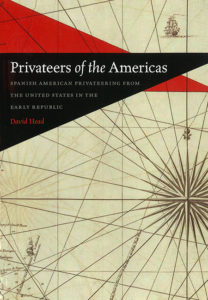 By David Head, The University of Georgia Press, Athens, GA (2015)
By David Head, The University of Georgia Press, Athens, GA (2015)
Reviewed by Joseph-James Ahern
David Head’s Privateers of the Americas: Spanish American Privateering from the United States in the Early Republic provides a wonderfully researched and written study into the issues faced by American merchants and sailors who participated in Spanish American privateering, as well as the frustration United States customs and naval officers faced as they tried to enforce the law. Spanish American privateering came from the crisis of the Spanish crown in 1808 following the French invasion when Napoleon ousted King Fernando VII and installed his brother Joseph Bonaparte as king of Spain. In response, Spanish colonies in America set up their own juntas to govern, some staying loyal to the crown, other seeing it as their time to declare independence. Lacking naval forces, these colonies turned to privateers. Into this situation sailed merchants, captains, sailors and filibusters from the United States who took up privateering for both noble and financial reasons.
Head’s goal in this study is to explore how Spanish American privateering worked, who engaged in it, how the United States government responded to it, and why those involved chose this course of action. As he states, “Re-creating the world of Spanish American privateering sharpens our picture of how the United States encountered the world in the early nineteenth century.” (5) To recreate that world, Head relies on the court cases held by the National Archives (both criminal and civil) relating to the legal actions against privateers in the Federal courts. In doing so, he creates a history that is personal – fleshing out who these individuals were and the multifaceted reasons why they engaged in privateering.
Understanding the diplomatic situation that existed between the United States, Spain, and Spanish American during this period is central to understanding how the United States responded to Spanish American privateers sailing from its shores. Head spends his first chapter sketching out the issues confronting the Spanish crown as Napoleon took charge of the country, and the efforts of the South American colonies to gain their independence – even after the monarch was returned. At first, the United States opted for neutrality as it was then in negotiations with Spain over retributions from the Quasi-War with France and to settle border negotiations regarding the Louisiana Purchase. The United States was friendly, but cautious towards the Spanish American republics; balancing security and border concerns, with issues of trade. Into this neutrality came the question of support for the Spanish colonies – while the law forbade active participation by citizens, it allowed for the trade of war supplies, one of many loopholes privateers would exploit. Americans themselves were supportive of the Spanish American independence movements – toasting them during July 4th celebrations, and naming children and towns after prominent Spanish American leaders. Over time, United States sentiment towards Spanish America cooled particularly in fear of the areas ties to Catholicism and its views toward slavery.
With the stage set, Head next looks at the United States locations from which privateers sailed: Louisiana, Baltimore, Galveston, and Amelia Island. The geographical and political nature of New Orleans made smuggling and privateering attractive business ventures. Of particular note were the Laffite brothers who established a dominant business at Barataria for auctioning and transporting smuggled goods into Louisiana, and helping supply and man privateers. Like New Orleans, Baltimore was active in South American privateering, with investors taking shares in the fitting out of ships. Given its location, Baltimore sent out larger ships on longer cruises to further locations (including near Spain itself). Head does a nice job of reviewing the mechanics of how Baltimore privateers obtained their commissions, made it out to sea, and disposed of their prizes. Unlike privateering out of New Orleans and Baltimore, the operations on Galveston and Amelia Island skirted around the issue of neutrality and sovereign status. At both locations, filibusters set up operations they declared to be either independent states, or part of the Mexican republic such as handing out commissions, and adjudicating prizes. Head also reviews government reaction to privateering in the different locations, particularly how legal loop holes and questions of neutrality towards belligerents hindered efforts of local authorities out of United States ports. Over time, changes in legislation and official policy impacted the profitability of those involved in privateering. Response to activities in Galveston and Amelia Island was influenced by their location and questions of sovereignty.
Equally important to how Spanish American privateers operated are the reasons why they chose this path. Head shows that those involved with Spanish American privateers (captains, sailors, merchants, and filibusters) did so for multifaceted reasons ranging from champions of freedom to opportunistic moneymakers and adventurers. In many cases, they did it for multiple reasons at once. As he states, “As a group, then, they were good and evil, noble and depraved, selfish and self-sacrificing, cosmopolitan and attached to one place.” (148) Head does note that the historical record is limited, and cannot address why thousands of individuals participated. However, using the sources at hand, he is able to illustrate why a handful of captains, sailors, and filibusters participated in this illegal activity.
Head’s Privateers of the Americas is a worthwhile library addition to anyone interested in the maritime history of the Atlantic world and Early Republic. It expands the readers understanding of what took place following 1815 with the end of international conflict and the resurgence of Caribbean piracy in the 1820s. While the study is light on naval action for naval historians, it does highlight the issues faced by naval officers on station near ports active in privateering as they endeavored to enforce United States law while simultaneously navigating the issues of Spanish American sovereignty. Overall, Privateers of the Americas is a well written and fascinating study of this overlooked part of American history.
Joseph-James Ahern is with the University of Pennsylvania

